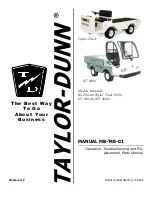
Operation
NOTE: These differentials require a certain amount of resistance
in order to start the power transfer. If the spinning wheel is off
the ground, transfer may not begin. If spinning occurs, often a
light application of the brakes, while carefully applying power,
will slow the spinning wheel enough to allow the differential to
transfer power to the other wheel.
The performance of a vehicle equipped with locking differential
is somewhat different from that of a vehicle equipped with a
conventional differential.
For example: Light noise and mild shuddering may be evident
while turning the vehicle on high coefficient of friction surfaces
(i.e., concrete). Vehicle and operating conditions can add to the
level of this noise and vibration:
•
Tight slow continuous turns, as encountered in tight
parking/delivery areas.
•
Higher axle ratios as compared to lower axle ratios.
•
Uneven tire air pressure and/or uneven tire wear.
•
Heavy vehicle loads and/or uneven side-to-side distribution
of load.
Anything that improperly causes a difference in individual wheel
speeds, such as mismatched tire diameters (due to differences
in tire wear or tire pressure), unbalanced loading of the vehicle,
or operating the vehicle on a side slope, may cause the locking
differential to deliver power to only one side of the vehicle,
thus affecting directional stability. Always maintain matched tire
sizes, pressures, and balanced loads and avoid operation on
side slopes.
Two Speed Rear Axle
WARNING
Never attempt to shift a two-speed axle when
descending a hill as the axle may not complete
the shift, remain in neutral, and cause a loss
of vehicle speed control and result in property
damage, personal injury, or death.
Do not attempt to shift a Two-Speed rear axle
when the rear tires are spinning as this could
cause a loss of vehicle control and result in
property damage, personal injury, or death.
The two-speed rear axle switch permits selection of either the
high or low axle ratio.
Axle Shift Only
TO DOWN SHIFT: Select lower ratio position, release and
depress accelerator pedal as quickly as possible, or while
holding the accelerator down, disengage and re-engage clutch
as quickly as possible.
NOTE: Clutch method recommended for slower speeds.
TO UPSHIFT: Keep accelerator down, select a faster ratio
position, release accelerator pedal and pause until axle shifts.
NOTE: De-clutch for smoother axle upshifts at slow speed.
3879634R1
135
Summary of Contents for WorkStar Series
Page 4: ...Operator s Manual WorkStar Series Printed in the United States of America 3879634R1...
Page 12: ...Table of Contents viii 3879634R1...
Page 48: ...Inspection Guide 36 3879634R1...
Page 52: ...Controls Features 40 3879634R1...
Page 65: ...Controls Features Declination Zone Map 3879634R1 53...
Page 100: ...Controls Features 88 3879634R1...
Page 214: ...Maintenance Instructions 202 3879634R1...
Page 238: ...Maintenance Intervals And Specifications 226 3879634R1...
Page 258: ...Index 246 3879634R1...











































